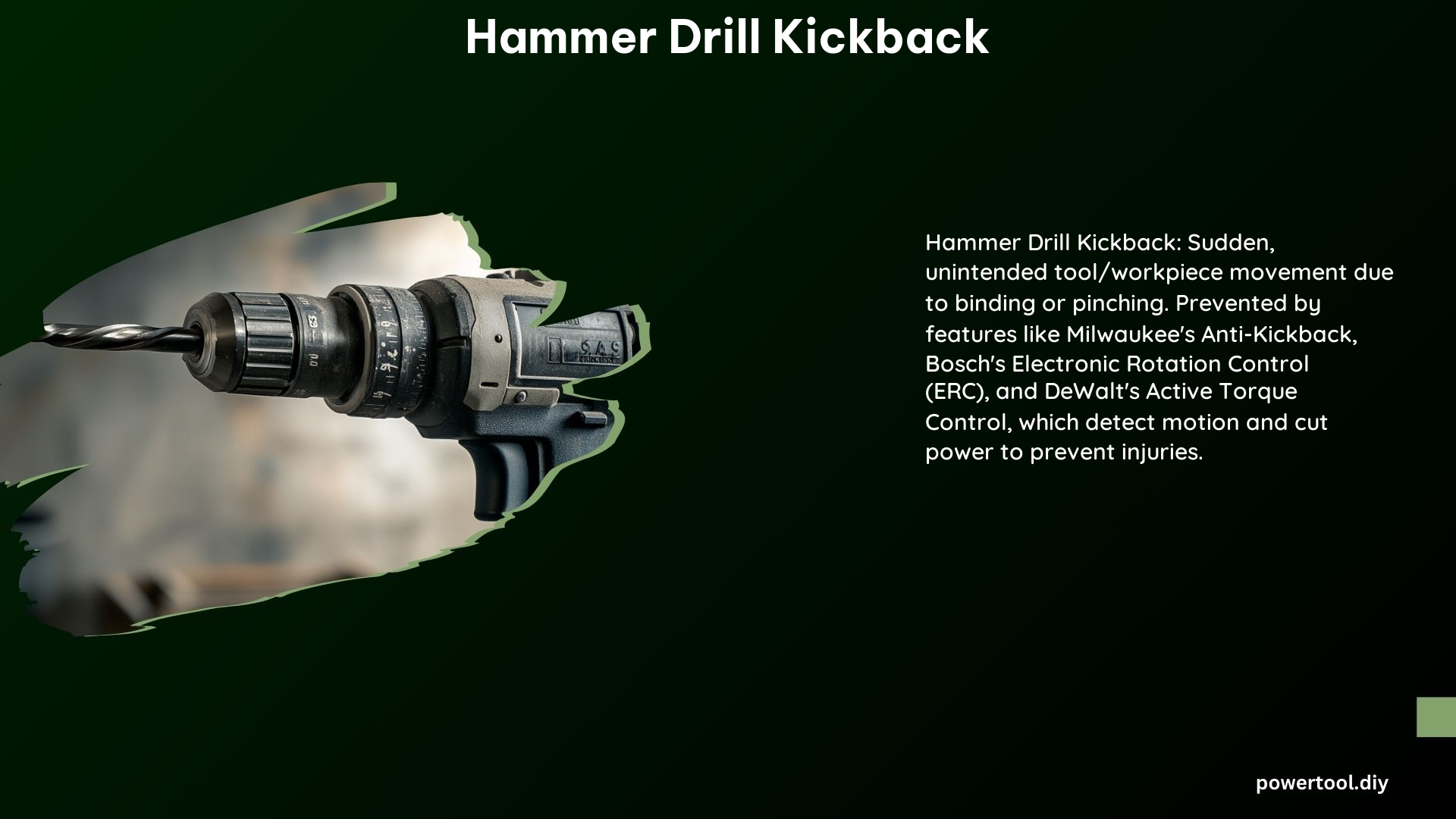Hammer Drill Kickback refers to the sudden and unintended movement of the tool or workpiece, typically caused by binding or pinching of the workpiece. This phenomenon can result in serious injuries, particularly when working at height or with high-torque drills. To address this issue, modern hammer drills have incorporated various anti-kickback technologies that aim to enhance user safety, protect the tool, and increase productivity.
Anti-Kickback Technologies
Bosch Kickback Control
Bosch’s Kickback Control technology electronically manages the rotation of the drill, limiting the rotary movement in case of kickback. It uses an integrated acceleration sensor that can detect sudden movements and immediately cut power to the motor, protecting both the user and the tool. The acceleration sensor has a response time of less than 15 milliseconds, allowing for a rapid and effective response to kickback events.
DeWalt Active Torque Control
DeWalt’s Active Torque Control feature senses the torque and rotation of the drill body to detect kickback. When a sudden change in movement patterns is detected, the technology works by cutting power to the motor, effectively stopping the drill and preventing further movement. This system can detect changes in torque as small as 1 Newton-meter (Nm) and react within 3 milliseconds, providing a high level of protection against kickback.
Hilti Active Torque Control
Similar to DeWalt’s technology, Hilti’s Active Torque Control also senses torque and rotation to prevent kickback. The system uses advanced algorithms to analyze the drill’s movement and immediately cut power to the motor when a sudden change in rotation or torque is detected. Hilti claims that their Active Torque Control can react within 3 milliseconds, offering a reliable and responsive anti-kickback solution.
Makita Active Feedback Sensing Technology
Makita’s Active Feedback Sensing Technology (AFST) uses an accelerometer to detect changes in drill movement and cuts power to the motor in case of kickback. The accelerometer has a sampling rate of up to 8,000 Hz, allowing it to quickly identify sudden changes in the drill’s motion. When a kickback event is detected, the system can shut off the motor within 15 milliseconds, providing a high level of protection for the user.
Milwaukee AutoStop
Milwaukee’s anti-kickback feature, known as AutoStop, detects motion in the drill and turns it off when the bit binds, preventing further movement and potential injuries. The system uses a combination of torque and motion sensors to continuously monitor the drill’s performance and immediately respond to any signs of kickback. Milwaukee claims that their AutoStop technology can react in as little as 3 milliseconds, offering an additional layer of safety for users.
Benefits of Anti-Kickback Technology

Enhanced Safety
The primary benefit of anti-kickback technologies is the reduction of injuries caused by kickback, particularly when working at height or with high-torque drills. By quickly detecting and responding to sudden movements, these systems can help prevent the drill from causing harm to the user or the surrounding environment.
Improved Tool Protection
Anti-kickback technology not only protects the user but also helps to safeguard the tool itself from damage caused by kickback. By cutting power to the motor and stopping the drill’s movement, these systems can prevent the drill from being thrown or damaged, extending the tool’s lifespan and reducing the need for costly repairs.
Increased Productivity
By minimizing the risk of kickback, users can work more efficiently and confidently, leading to increased productivity. With the added safety and protection provided by anti-kickback technologies, workers can focus on their tasks without the constant worry of unexpected tool movements, allowing them to complete their work more quickly and with greater precision.
Technical Specifications
Acceleration Sensors
Many anti-kickback technologies rely on integrated acceleration sensors to detect sudden changes in drill movement. These sensors are typically capable of sampling at high frequencies, often in the range of 8,000 Hz or more, allowing them to quickly identify and respond to kickback events.
Electronic Braking
When a kickback event is detected, the power to the motor is cut, effectively braking the drill and preventing further movement. This electronic braking system can react within milliseconds, providing a rapid and effective response to sudden changes in the drill’s motion.
Brushless Motors
Modern hammer drills often feature brushless motors, which are electronically commutated and can be controlled by a computer to implement anti-kickback features. Brushless motors offer several advantages, including improved efficiency, increased power density, and enhanced durability, making them well-suited for integration with advanced anti-kickback technologies.
Conclusion
Hammer Drill Kickback is a serious safety concern that can lead to injuries and tool damage. However, the development of sophisticated anti-kickback technologies has provided users with a range of solutions to mitigate these risks. By understanding the technical specifications and capabilities of these systems, users can make informed decisions when selecting a hammer drill that best suits their needs and ensures a safe and productive work environment.
References
- https://www.youtube.com/watch?v=OmiMpA-S8W4
- https://www.toolstop.co.uk/blog/knowledge-base/how-to-deal-with-power-drill-kickback
- https://www.reddit.com/r/Tools/comments/m2mcuj/i_have_to_admit_antikickback_on_high_torque/
- https://onekeyresources.milwaukeetool.com/en/how-to-stop-drill-kickback
- https://www.youtube.com/watch?v=Bmcquot_yNQ
